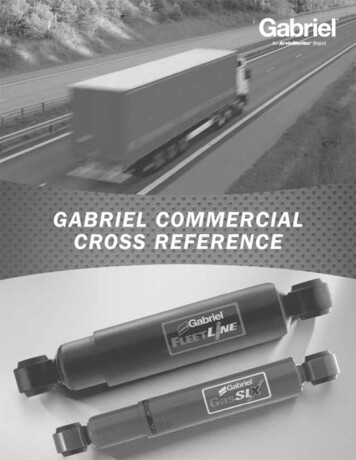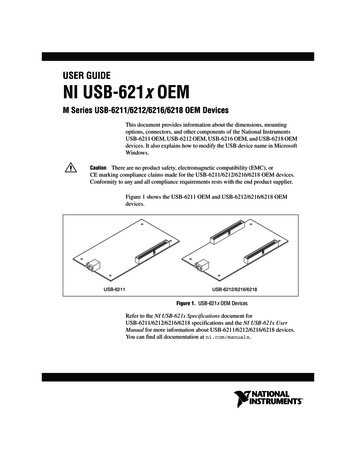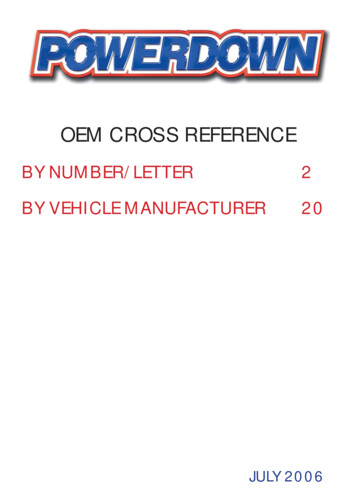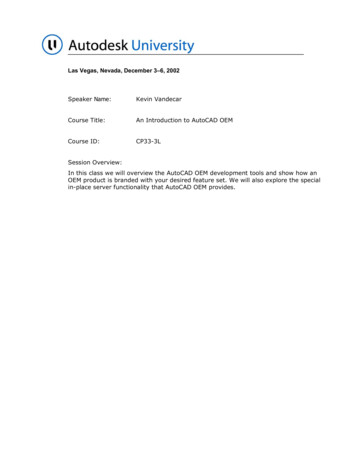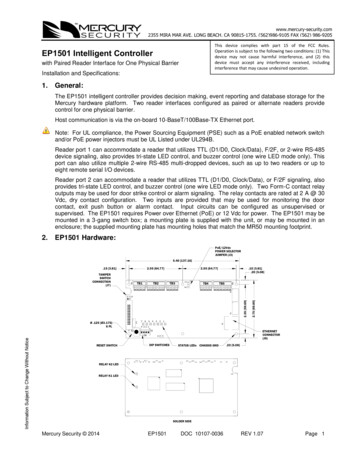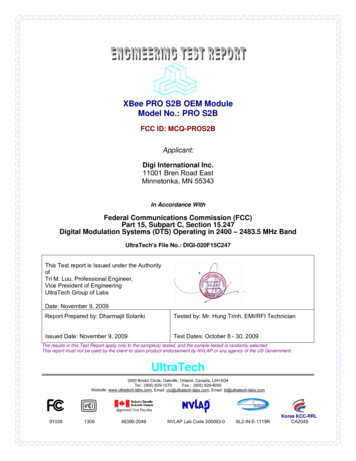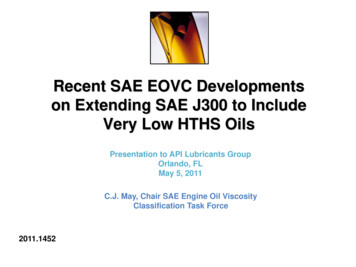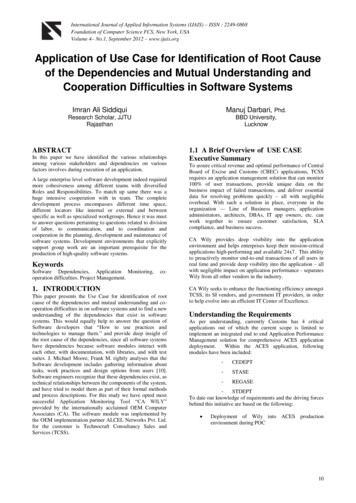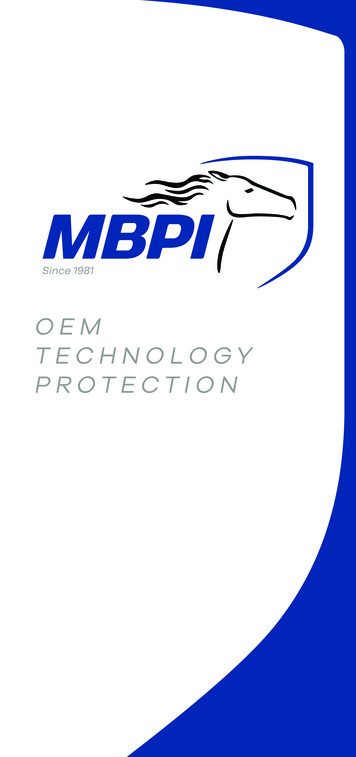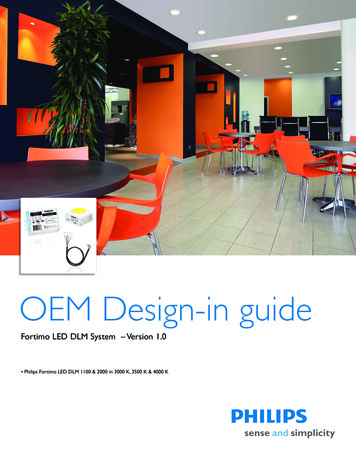
Transcription
OEM Design-in guideFortimo LED DLM System – Version 1.0 Philips Fortimo LED DLM 1100 & 2000 in 3000 K, 3500 K & 4000 K
Contents1. IntroductionFeatures and benefitsApplications3442. LEDs, the heart of the Fortimo downlight moduleWhat is a LED?LED packagingBinningLUXEON Rebel LEDsFortimo LED DLM addresses the issue of binningColor consistency (SDCM)Miniaturization555666773. Philips Fortimo LED DLM systemFortimo LED DLM portfolio77Fortimo LED DLM “4000 K”Fortimo LED DLM “3500 K”Fortimo LED DLM “3000 K”Fortimo LED DLM cableFortimo LED DLM driverThe basic principles of the Fortimo LED DLM systemStarting characteristicsLuminous flux during start periodLumen maintenanceDimmingFuture range extensionsNomenclatureAbout the Fortimo LED DLM (downlight module)Dimensions of Fortimo LED DLM module and driverMechanical fixationAbout the Fortimo LED DLM driverAbout the Fortimo LED DLM cables777778888889991010104. System performance specifications115. Lighting performance characteristicsSpecification of the system after 100 hoursUV and other hazardsSpectral power distribution 3000K, 3500K, 4000KDimming characteristics12121213136. Designing a luminaireUL recommendationsElectrostatic device (ESD) measures141414Installation instructionsWiringConnecting to the mains supplyConnecting to protective groundConnecting to 12 V14141414142Design-in guide Philips Fortimo LED downlight module systemConnecting a Fortimo LED DLM driver to the moduleFortimo LED DLM cableOutdoor luminairesSecondary optics7. Heat sink design and temperature measurementsGeneralTest requirementsMaximum temperatureCritical measurement pointsOperation under built-in conditionsCase temperature and thermal circuitCase temperature and Fortimo module performanceOperation in free airHeat sink designThermal conductivityEmission coefficientsSize of heat sinkActive and passive coolingPassive coolingAir flowThermal designFrom the temperature test point Tc (point 1)to the side surfaces (point 2)From the heat sink to ambient (point 3)Thermal modelCalculating your heat sinkFrom the datasheet:Shape of heat sinkThe Fortimo LED DLM with the two connectedheat sinks and three thermo couples installedHow to measure TcSynJet cooling from NuventixNuventix contact information8. Lighting installations and the environmentElectromagnetic compatibilityHumidityExposure to direct sunlightVibration and shocksStandards and approvalsIP codes, dust and moisture protectionEnd-of-life behaviorFortimo LED DLM system disposal9. Schematic luminaire with theFortimo LED DLM 20212222232323242425252525252525252526
1. IntroductionThank you for choosing the Philips Fortimo LED DLM system.This guide tells you all about this system. If you require any further informationor support please consult your Philips sales representative or visit:www.philips.com/fortimoThe advantages of LEDs have been known for 40 years: Long life – low maintenance cost Robustness – high reliability Saturated colors – maximum visual effect Cool beam – no heating of illuminated products No UV or IR – wide application possibilities Low-voltage operation – more safety, ease of use Mercury-free – care for the environmentRapid improvements in high-power LED technology mean that LEDs can now be used for the firsttime in ‘real’ lighting applications, providing improvements over traditional lighting systems.Utilizing LED technology has its challenges, such as how to design around constant performanceimprovement, how to engineer and provide appropriate heat sinking and/or how to deal withvariations in flux/color. The Fortimo LED DLM system addresses these differences and facilitateseasy adoption of LED technology for high lumen packages (1000 lumens plus). The system isdesigned for integration in luminaires. This technical application guide addresses the relevant issuesto support and facilitate the work of specifiers and lighting system designers.The Fortimo LED DLM system is, as the name suggests, designed and intended for downlightluminaires. Other applications can be explored by OEMs as long as this creates no design conflictswith the Fortimo LED DLM system and local standards. Please consult us if you wish to deviatefrom the design rules as described in this design-in guide.Reference the Philips web site for complimentary heat sink or reflector product information.Design-in guide Philips Fortimo LED downlight module system3
Features and benefitsFeaturesBenefitsBreakthrough LED L3 energy savingLED system suitable for functional lighting applications.Patented remote phosphor technologyFortimo driver 85% efficiencyEfficient, easy to meet Energy Star driversSuperior-quality white LED lightAn enabler for entry into general lighting1100 & 2000 lm modulesCompetes with CFL systemsCRI 80, 3000 K, 3500 K, 4000 KMeets the norms for general lightingRemote phosphorVery high (optical) luminaire efficienciesOptimized light mixing chamberPerfectly mixed light, consistent color quality and lumen outputDedicated binning strategyFuture-proofed, convenient modulesFixed form factorEasy to work with for OEMsFixed lumen packageFewer technical barriersEasy-to-mount heat sink/opticsFaster time-to-marketComfortable lightEasy for the end user to experienceNo heat or UVMore comfortable, no damage to materialsDimmable, instant 100% lightMultiple scene-setting optionsLong lifetime of 50,000 hrsLow-maintenanceIntegrated lifetime-preserving methodMore reliable, longer life3000 K, 3500 K & 4000KWarm color options available tooFortimo DLM DriverEase of installationDimmable via 0–10 V ProtocolDimming increases efficiency up to 30%ApplicationsThe Fortimo LED DLM system is intended for general lighting applications in the professional market foroffices, hospitality and retail. Examples of applications include: Offices (representative areas such as receptions, boardrooms, etc.) Public buildings (cinemas, restaurants, theaters, airports, exhibition halls) High-end shops Retail (supermarkets, bakery/butcher areas, leather goods, etc.)* Use in outdoor luminaires?Neither the Fortimo LED DLM module nor the LED driver has an IP classification.If an OEM decides to use the Fortimo system in a luminaire for outdoor application, the OEM is responsible forproper IP protection and approbation of the luminaire.4Design-in guide Philips Fortimo LED downlight module system
2. LEDs, the heart of the Fortimo downlight moduleThe development of Light Emitting Diodes (LEDs) is progressing at such a pacethat they are rapidly gaining importance for lighting applications. To most people,the term LED still only means the small indicator lights that show whether theTV set is switched on. These tiny light sources barely emit enough light to makethemselves visible. However, breakthroughs made in the last few years now allowLEDs to be used for ‘real’ lighting applications that have traditionally been thedomain of incandescent lamps and discharge lamps. Philips Lumileds was thefirst to bring high power LEDs for lighting applications to the market under theLuxeon trademark. Luxeon emitters are among the highest-performance LEDs inthe world, allowing us to offer the brightest solid-state lighting solutions.What is a LED?LEDs are solid-state devices, built up from crystalline layers of semiconductor material. The lightgeneration process makes use of the special electronic properties of crystalline semiconductorsin a process called injection luminescence. In brief, this means the injection of charged particlesby an electric field from one semiconductor layer into another, where they are able to relax toa lower-energy state by emitting visible light. LEDs produce narrow light spectra. The bandwidthremains limited to a few tens of nanometers, and is therefore perceived by the human eye asa single, deeply saturated color. LEDs are now available in all wavelength regions of the visiblespectrum; yellow is the only region in which no high-power LED is currently available. Whitelight can be produced by combining LEDs of different colors (for instance red, green and blue),or by applying phosphor coatings on blue or ultraviolet LEDs. Like many other lamps, LEDscannot be connected directly to the mains. The LEDs have to be operated at a stabilized lowvoltage, which is provided by driver electronics. However, LEDs do not need ignition and can beswitched within milliseconds. LEDs do not generate nearly as much heat as many otherlamps,but that does not mean that thermal design is not important. LEDs do produce heat when theyoperate, and are themselves relatively sensitive to temperature. Thermal considerations aretherefore very important aspects of LED lighting system design.LED packagingThe bare LED die is still a very sensitive and fragile device that must be handled in a cleanroom environment. Before bringing them outside, they must be packaged. The light flux ofconventional LEDs, for example those used as indicator lights on TV sets, is severely limitedby the amount of heat generated. In practice, conventional LED packages are limited to about0.15 W at most, and emit only a few lumens. Their light is too weak to be used for illuminationpurposes, and they can only be used for luminance applications (i.e. when the light source isintended to be viewed directly). A breakthrough came with a new package design inventedby Philips Lumileds, which guides away the heat generated at the diode junction much moreefficiently. LEDs based on this package are sold under the trademark Luxeon.Design-in guide Philips Fortimo LED downlight module system5
Instead of an epoxy cap, the chip is encapsulated in a silicone lens. This package design nowmakes high-power LEDs feasible.BinningThe subject of binning should be explained because of its importance in LED system design.As in other semiconductor manufacturing processes, in LED production the number ofparameters of the epitaxy process is very large and the process window small (for example,the temperature must be controlled to within 0.5 C ( 1 F) across the wafer at temperaturesof 800 C/1470 F). The difficulty of achieving such a high degree of control means thatthe properties of the LEDs may vary significantly within single production runs and even onthe same wafer. To obtain consistency for a given application, binning ( selection in bins) ismandatory. Binning involves characterization of the LEDs by measurement and subsequentlycategorizing them into several specific bins. To keep the cost per LED down, LED manufacturersmust sell the full production distribution. At the same time they cannot guarantee the availabilityof all bins at all times. There is a trade-off between logistics and cost price on the one hand,and the application requirements on the other. Setting the specification too tightly will increasethe cost price and may lead to logistics problems. System design should therefore try tocombine LEDs from different bins intelligently to obtain the required system performance at areasonable price and with reasonable delivery reliability.LUXEON Rebel LEDsLUXEON Rebel is the smallest surface mountable power LED available today. With theindustry’s best lumens per package, highest light density (lumens per mm2), and the highestpacking density, LUXEON Rebel is ideal for both space constrained and conventional solidlighting applications. Due to the small mounting surface we have been able to use multipleLUXEON Rebel with the Fortimo products in order to match required high lumen packages.LUXEO Rebel LED6Fortimo LED DLM addresses the issue of binningHigh-quality LED light is achieved by mixing the light of blue LEDs and applying a specialFortimo phosphor technology remote from the LEDs. High-quality white light is characterizedby a color rendering of 80, popular CCTs in general lighting applications of 3000 K, 3500 Kand 4000 K and a color consistency comparable with conventional CFL and HID solutions(five SDCM).Design-in guide Philips Fortimo LED downlight module system
003504000300CIE 1931 xy45000.43450000.4140.394y65000.37475000.354Color consistency (SDCM)The target specification of Fortimo LED DLM systems for color consistency is 5 SDCM @ 0-hoursand 6 SDCM @ 10 K hrs. This is a similar specification as for conventional CFL lamps. SDCM standsfor Standard Deviation of Color Matching and the value 5 refers to the size of an ellipse around theblack body locus. Staying within this ellipse results in a consistency of light that ensures that fromone luminaire to another no difference can be noticed. In the visual we have plotted 3000 FortimoLED DLM systems and you can see they all fit within the 5 SDCM ellipse. This really demonstratesthe unique quality of the remote phosphor concept. We also plotted these results in a typical bindistribution sheet of Philips Lumileds. As you can see all Fortimo’s fit within 1 color bin! Typically youcan buy 6 to 12 bins combinations, not so precise as the 1-bin result of Fortimo.100000.334MiniaturizationxColor consistency (SDCM)0.4380.4180.3980.3780.3580.3380.3180.314LEDs are typically much smaller than conventional light sources. Lighting designers and specifiersimmediately recognized the fact that LEDs allow dramatically different lighting designs that capitalizeon these tiny, unobtrusive light sources. This is understandable, but care must also be taken to dealwith the heat produced by power LEDs. Proper heat management places limits on miniaturization.3. Philips Fortimo LED DLM systemFortimo LED DLM portfolioThe Fortimo family of products has been ever-evolving since it’s introduction in 2008. Bymaintaining its sleek footprint, OEMs can benefit from the simplicity of it’s easy-to-use,future-proof design. The existing portfolio is as follows:Fortimo LED DLM “4000 K”9290098403 Fortimo LED DLM1100 17W/840UL9290098603 Fortimo LED DLM2000 33W/840ULFortimo LED DLM systemFortimo LED DLM “3500 K”9290099603 Fortimo LED DLM1100 18W/835UL9290099703 Fortimo LED DLM2000 34W/835ULFortimo LED DLM “3000 K”9290098303 Fortimo LED DLM1100 19W/830UL9290098503 Fortimo LED DLM2000 36W/830ULFortimo LED DLM cable442240066181 Fortimo LED DLM cable 500mm w/o fan442240068381 Fortimo LED DLM cable 500mm w/fan442240072121 Fortimo LED DLM cable 840mm w/o fanFortimo LED DLM driver913701213402 Fortimo LED driver (120-277V, 0-10V dim)Design-in guide Philips Fortimo LED downlight module system7
The basic principles of the Fortimo LED DLM systemThe Fortimo LED DLM system is designed for downlight applications and contains threecomponents: The Fortimo LED DLM (downlight module) The Fortimo LED DLM dimmable driver The Fortimo LED DLM cableAll products can be ordered separately.Starting characteristicsThe system can be switched on in milliseconds, which is a general characteristic of LEDs.Luminous flux during start periodIn contrast to other light sources, LEDs can be switched on at full power (or at any other dimmedlevel) instantaneously. The Fortimo LED DLM system requires no initial burning-in time.Lumen maintenanceWhen used within specification, (Tc 65º C; Ta 35º C) lumen maintenance of 70% at 35,000hours is expected for Fortimo LED DLM. At 50,000 hours lumen maintenance is 50% (averagelifetime specification).DimmingTo enable the Fortimo LED DLM system to dim, a special Fortimo LED driver has been developed.Due to the use of an Amplitude Modulation (AM) (not PWM) protocol the efficiency of theFortimo system will increase up to 30% while dimming.Future range extensionsAs technology quickly advances, the Fortimo family is still growing. The following products areexpected soon: Fortimo LED DLM upgrades that improve efficiency and lower cost (depending on theproduct proposition). Fortimo with emergency functionality Fortimo LED DLM with a 3000 lumen packageFortimo LED DLM module8Design-in guide Philips Fortimo LED downlight module system
NomenclatureThe names of the products are defined as follows: Fortimo LED DLM1100 17W/840UL (CRI of 80 and CCT of 4000 K) Fortimo LED DLM2000 33W/840UL (CRI of 80 and CCT of 4000 K) Fortimo LED DLM2000 34W/835UL (CRI or 80 and CCT of 3500 K) Fortimo LED DLM1100 18W/835UL (CRI of 80 and CCT of 3500 K) Fortimo LED DLM1100 19W/830UL (CRI of 80 and CCT of 3000 K) Fortimo LED DLM2000 36W/830UL (CRI of 80 and CCT of 3000 K) Fortimo LED DLM cable Fortimo LED DLM driverAbout the Fortimo LED DLM (downlight module)The Fortimo LED DLM consists of four main components:1. PCB with LEDs2. Mixing chamber3. Heat sink4. Diffuser with remote phosphor technologyC1C2A3B1A1Dimensions of the Fortimo LED DLM module and driver system(typical data; 0.2 mm) Maximum current settings of 700mA Class 2 and isolated output Maximum 56V enables classification 0-10V Dimmable of the system as a UL Class 2 power supply Connectorized High efficiency: 85% at full load Small Size Tcase life 75 0.076.4106.750.8Fortimo LED DLM module - dimensionsF3GNote: Dimensions are in millimeters (mm)F2F4FFortimo LLM driverFortimo LED DLM driver - dimensionsF1F2F3F4G14.55" (116.6)1.18" (30.0)3.00" (76.4)4.20" (106.7)2.0" (50.8)Design-in guide Philips Fortimo LED downlight module system9
Fortimo LED DLM module, fixing holes and groovesHigh-quality white light with high efficiencies is achieved with a plain PCB with LEDs and a remotephosphor film layer. The mixing chamber ensures perfectly mixed light, resulting in uniformcolors and good color consistency. The square heat sink facilitates optimal heat transfer in threedirections and helps luminaire manufactures to design their own heat sink system. The heat sink isequipped with screw holes for fixing the heat sink. Besides facilitating high efficiencies, the remotephosphor technology makes it relatively easy to develop virtually any fluorescent color. The firstversion will have a light color of 3000 K, 3500 K and 4000 K. The function of the diffuser is toshape the light distribution, resulting in a Lambertian beam. The luminaire manufacturer has thefreedom to design its own secondary optics. The LED module integrates easy mounting optionsfor secondary optics. The overall dimensions of the LED module, i.e. the combination of heat sinkand mixing chamber, are optimized for lumen packages varying from 1000 lumen to 2000 lumen.Mechanical fixationThe Fortimo LED DLM has screw holes (M4 threaded head size less than 7 mm) at the bottomand sides of the heat sink for fixing the heat sink. As an alternative to screws the Fortimo LEDDLM also has grooves at the side of the module so that a heat sink can be clicked in. 2D or 3DCAD drawings are available on the Philips website.Fortimo LED driver1BlackLed 2 YellowLed -3—Blank4 GraySignal GND/Fan (-)5 BlueLED module setting6 RedNTC (thermal control)Fortimo LED DLM cableAbout the Fortimo LED DLM driverThe highly efficient Fortimo LED driver is specially designed to operate the Fortimo LED DLMmodule. It is designed to operate high-power LEDs. There are specific versions for Europe (220240 V) and North America (120-277 V)* because of different housing requirements.There are meanwhile various Fortimo LED drivers: Fixed output; build-in for Europe* (220-240 V) and North America (120-277 V)Special features for this Intellivolt dimmable driver are: maximum current settings of 700 mA max. 56V enables operation of many LEDs in series Tcase 65º C Safety Class 2 system* A separate design-in guide is available for the European Fortimo DLM system.About the Fortimo LED DLM cablesStandard 500 mm and 840 mm cables without fan and 500 mm cable with fan can be ordered.10Design-in guide Philips Fortimo LED downlight module system
4. System performance specificationsFortimo LED DLMModuleDriverSystem (driver and12NC12 NCCable mNomNomNom120-277V19 0.9 201100442240066181120-277V18 0.9 201100913701213402442240066181120-277V17 0.9 36 0.9 34 0.9 33 0.9 202000(%)module)Fortimo LED DLM110019W/830 ULFortimo LED DLM110018W/835 ULFortimo LED DLM110017W/840 ULFortimo LED DLM200036W/830 ULFortimo LED DLM200034W/835 ULFortimo LED DLM200033W/840ULFortimo LED DLMEff.B50L70 @ TCB50L70 @ TCTambTcase ModuleTcase DriverSystem (driver and(lm/W)55C of Module65C of Module(ºC)(ºC)(ºC)NomNomNomNomtypmaxtypmax5850K hrs35K hrs(-20) to 35556575856150K hrs35K hrs(-20) to 3555)6575856450K hrs35K hrs(-20) to 3555)6575855550K hrs35K hrs(-20) to 35556575855850K hrs35K hrs(-20) to 35556575856150K hrs35K hrs(-20) to 3555657585module)Fortimo LED DLM110019W/830 ULFortimo LED DLM110018W/835 ULFortimo LED DLM110017W/840 ULFortimo LED DLM200036W/830 ULFortimo LED DLM200034W/835 ULFortimo LED DLM200033W/840ULDesign-in guide Philips Fortimo LED downlight module system11
5. Lighting performance characteristicsSpecification of the system after 100 hoursFortimo LED DLMLightColorColorColorSystem (driver al and atmodule)10K hrsFortimo LED 0805/619W/830 ULFortimo LED DLM110018W/835 ULFortimo LED DLM110017W/840 ULFortimo LED DLM200036W/830 ULFortimo LED DLM200034W/835 ULFortimo LED DLM200033W/840 ULUV and other hazardsPET valueDamage factorIR (infrared) radiation12Design-in guide Philips Fortimo LED downlight module system 100 hrs./Klux (zero UV)0.08 @ 4100 K As well as being free of UV radiation,the LED modules are also free of infrared radiation in the beam.
Spectral Power Distribution 3000K, 3500K and 4000K34e5t6al 478e6 9ist6i:; 7n 76 m7 ?@ @ A BCCCD0.040.035Intensity 30680730780730780730780Wavelength (nm)34e5t6al 478e6 9ist6i:; 7n 76 m7 ?@ @ A BCDDE0.040.035Intensity 30680Wavelength (nm)34e5t6al 478e6 9ist6i:; 7n 76 m7 ?@ @ A BCCCD0.0450.04Intensity 0580630680Wavelength (nm)Figure ALED Current700 mAAM Dimming100% lightlevel700 mALED CurrentLED Current700 mA50% lightlevel50% lightlevelPWM DimmingDimming characteristicsFortimo Driver makes use of a so-called amplitude (AM) dimming protocol. Most LED systemswork with PWM (pulse width modulation) where the current is cut in parts and dimming levelsare achieved by combining, on high frequency, on/off settings (pulses). AM dimming reduces thecurrent through the LEDs to achieve lower light levels. At lower currents, LEDs operate moreefficiently (Figure A). In addition to this, other advantages of AM dimming are: No audible noise during dimming No visual interference with other lighting or video sources Improvement of overall performanceDesign-in guide Philips Fortimo LED downlight module system13
6. Designing a luminaireIn this chapter recommendations and values are given to enable optimal luminaire design.U.L. recommendationsThe general recommendations for luminaire design given by the U.L. 1598 and U.L. 8750 are alsoapplicable to LED-based luminaires.Electrostatic device (ESD) measuresFortimo LED DLM systems do not require special ESD measures in a production environment.Installation instructionsFortimo LED DLM systems are build-in systems for integration into luminaires.There are interfaces for: Cabling between LED module, driver and luminaire Secondary optics via mounting options in the LED module housing and reflector rim Heat sink designWiringConnecting to the mains supplyThe mains supply has to be connected to the power supply (L & N can be switched).Label Fortimo LED DLM moduleConnecting to protective groundThe Fortimo LED driver needs to be connected to protective ground for reasons of compliancewith safety regulations and EMI.Connecting to 12 VThe Fortimo LED DLM version includes also a 12 V output that can be used for variousoptions, like: Active cooling of Nuventix SynJet (Universal) DLM Coolers Other 12 V operating fans Note that when the LED current is 200mA, due to dimming, the 12V output is switched offConnecting a Fortimo LED driver to a Fortimo LED moduleA specific cable has been developed to connect the Fortimo LED module and the LED driver;the Fortimo LED DLM cable. This 500 mm cable can be ordered separately to the Fortimo LEDDLM systems.Fortimo LED DLM cable14Design-in guide Philips Fortimo LED downlight module system
Fortimo LED DLM cableWe advise using the Fortimo LED DLM cable. However if an OEM prefers to have a cablewith a different length it has to organize this itself. The cable specification should meet ULrequirements. However, approval of the Fortimo LED DLM module and LED driver is basedon a reference luminaire with the standard cable length of 600 mm. In any case, any luminairedesign needs its own approval, organized by the responsible OEM, irrespective of the length ofcable used.If an OEM prefers to have a cable with a different length it can use the following cable/connector specifications:JST connector at cable to LED module:- housing JST PAP-06V-S- contact JST SPHD-001T-P0.5Ferrule connector at cable to LED driver:- Wago sire ferrule - 216-201- Wago Two wire ferrule - 51018076Outdoor luminairesNeither the Fortimo LED DLM module nor the LED driver has an IP classification. If an OEMdecides to use the Fortimo system in a luminaire for outdoor application, it is responsible forproper IP protection and approval of the luminaire.Secondary opticsThe Fortimo LED DLM module generates a Lambertian beam shape which is a pragmaticstarting point for secondary optic design by OEMs. Ray-set files are available upon request.The secondary optic design should not cover the exit aperture.It is not recommended to put a secondary optics (ie. a lens or a filter) within 70 mm ofthe Fortimo light exit window. When the product is installed according to guidelines, thetemperature of the light exit window will be below 105 C. When the customer decides toplace secondary optics within 70 mm of the light exit window, the customer should take carethat the temperature of the material will not exceed 105 C for performance and 115 C forsafety. The temperature of the light exit window can be measured with Infrared temperaturesensing technique.On top of the Fortimo LED DLM there are mountingoptions (rim of diffuser and three mounting holes) forpositioning secondary optics.Position of secundary opticsPolar intensity diagramDesign-in guide Philips Fortimo LED downlight module system15
7. Heat sink design and temperature measurementsTc Ø1cmTemperature test point TCGeneralFor optimum performance the Fortimo LED DLM system must operate within specifiedtemperature limits.Test requirementsThe Fortimo LED DLM systems have no specific measurement for minimum ambienttemperature, which may be as low as -20º C. This minimum limit is determined by the FortimoLED driver. Temperature measurements should only be performed when the luminaire isthermally stable, which may take 0.5 to 2 hours depending on the thermal capacity of theluminaire. For all measurements such as temperature, luminous flux and power, a stabilizationperiod of at least half an hour must be allowed before any reliable data can be obtained.Measurements must be performed by means of thermocouples that are firmly glued to thesurface (and not, for example, secured with adhesive tape).Maximum temperatureBecause LEDs are temperature-sensitive, LED modules require a different approach withrespect to the maximum permissible component temperature. This is different to most othertypes of light sources.Critical measurement pointsFor LEDs, the junction temperature is the critical factor for operation. Since there is a directrelation between the case temperature and the LED junction temperature, it is sufficient tomeasure the aluminum casing of the LED module at its critical point. The critical point is on theback surface of the LED module. If the case temperature (Tc) at the critical measurement pointis too high (exceeding the recommended maximum temperature), the performance of the LEDswill be adversely affected, for example in terms of light output, lifetime or lumen maintenance.Operation under built-in conditionsThe heat produced by the LED driver and LED module in the luminaire (or similar housing)must be dissipated to the surroundings. If a luminaire is physically insulated by a ceiling, wall orinsulation blanket, the heat produced cannot easily be dissipated. This will result in heating ofthe LED driver and the LED module in the luminaire, which in turn can have an adverse effecton system performance and lifetime. For optimum performance and lifetime, it is important that: Air can flow freely around the luminaire Airflow through the luminaire and around the modules, must have a positive effect ontemperature control and hence on performance and lifetime.16Design-in guide Philips Fortimo LED downlight module system
Case temperature and thermal circuitTo ensure the performance of the Fortimo LED DLM system, we have defined a Tc at the backsurface of the LED module of 65º C. At that case temperature the junction temperature of theLEDs is assured and the indicated performances (lifetime, light output, lumen maintenance) canbe realized. Above a Tc of 65º C, a thermal circuit will be engaged. This circuit will dim the LEDmodule. The graphs below display the typical case temperature and relative flux as a functionof ambient temperature, for a calculated heat sink performance of 1 K/W. The Fortimo LEDdriver also has a Tc of 65º C.The above-mentioned engagement of the thermal circuit at Tc 65º C is applicable to boththe 1100 and the 2000 lumen versions. The performances of light output, light maintenance andlifetime are related to the Tc value.Case temperature and LED module performanceThe Fortimo LE
6 Design-in guide Philips Fortimo LED downlight module system Instead of an epoxy cap, the chip is encapsulated in a silicone lens. This package design now makes high-power LEDs feasible. Binning The subject of binning should be explained because of its importanc
